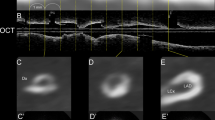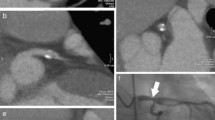Abstract
This study evaluated the diagnostic value of electron beam tomography (EBT) for detection of coronary artery disease and compared different quantitative parameters of coronary calcification to angiographic findings. Coronary calcification is a sensitive marker of coronary atherosclerosis and is of value in predicting coronary artery disease. One hundred twenty patients (mean age 55 years) underwent EBT and coronary angiography. Coronary calcification was quantified by calcified area, number, and CT density of calcified lesions and a calcium score defined by the product of calcified area, number, and CT density of calcified lesions. The quantity of calcification was related to the number of coronary vessels with significant stenosis and to the maximal degree of stenosis in angiography. The positive predictive value of EBT was 94%; negative predictive value was higher in older than in younger subjects (56% vs 94%). Quantity of calcification increased corresponding to the extend of coronary artery disease. Mean calcified area increased in significant one-vessel disease (9.3-fold), two-vessel disease (24-fold), and three-vessel disease (34.7-fold) compared with values in subjects without coronary artery disease. Calcified area in women with coronary artery disease was lower than in men, however, this difference decreases with age from 6.3-fold (age <50 years) to 1.8-fold (age >60 years). Detection of coronary calcification, helped in this study to distinguish, with high significance, between the presence or absence of coronary artery disease. The quantity of coronary calcium increased with the angiographic degree of coronary artery disease but due to the variation of calcification within a disease category the differentiation between disease category was not absolutely certain.
Similar content being viewed by others
References
Bundesministerium für Gesundheit (1993) Daten des Gesundheitswesens—1993. Nomos Verlagsgesellschaft: Baden-Baden, pp 164–167.
Friedewald ST (1992) Epidemiology of cardiovascular disease. In: Cecil's Textbook of Medicine, Wyngaarden and Smith (eds). Saunders: Philadelphia, pp 151–155.
Blankenhorn D (1961) Coronary arterial calcification: A review. Am J Med Sci 242:41–49.
Faber A (1912) Die Arteriosklerose, ihre pathologische Anatomie, ihre Pathogenese und Aetiologie. G. Fischer: Jena.
Detrano R, Markovic D, Simpfendorfer C, et al. (1985) Digital subtraction fluoroscopy: A new method of detecting coronary calcification with improved sensitivity for the prediction of coronary disease. Circulation 71:725–732.
Detrano R, Froelicher V (1987) A logical approach to screening for coronary artery disease. Ann Intern Med 106:846–852.
McGuire J, Schneider HJ, Chou TC (1968) Clinical significance of coronary artery calcification seen fluoroscopically with the image intensifier. Circulation 37:82–87.
Ureysky BF, Rifkin RD, Sharma SC, Reddy PS (1988) Value of fluoroscopy in the detection of coronary stenosis: Influence of age, sex, and number of vessels calcified on diagnostic efficacy. Am Heart J 115:323–333.
Margolis JR, Chen JTT, Kong Y, Peter RH, Behar VS, Kisslo JA (1980) The diagnostic and prognostic significance of coronary artery calcification. Radiology 137:609–616.
Loecker TH, Schwartz RS, Cotta CW, Hickman JR (1992) Fluoroscopic coronary artery calcification and associated coronary disease in asymptomatic young men. J Am Coll Cardiol 19:1167–1172.
Agatston AS, Janowitz WR, Hildner FJ, Zusmer NR, Viamonte M, Detrano R (1990) Quantification of coronary artery calcium using ultrafast computed tomography. J Am Coll Cardiol 15:827–832.
Breen JF, Sheedy PF, Schwartz RS, Stanson AW, Kaufmann RB, Moll PP, Rumberger JA (1992) Coronary artery calcification detected with ultrafast CT as an indication of coronary artery disease. Radiology 185:435–439.
Tanenbaum SR, Kondos GT, Veselik KE, Prendergast MR, Brundage BH, Chomka EV (1989) Detection of calcific deposits in coronary arteries by ultrafast computed tomography and correlation with angiography. Am J Cardiol 63:870–872.
Assmann G, Schulte H (1987) The prospective cardiovascular Münster study: Prevalence and prognostic significance of hyperlipidemia in men with systemic hypertension. Am J Cardiol 59:9G-17G.
European Atherosclerosis Society Study Group (1988) The recognition and management of hyperlipidaemia in adults: A policy statement of the European Atherosclerosis society. Eur Heart J 9:571–600.
Eggen DA, Strong JP, McGill HC (1965) Coronary calcification—relationship to clinically significant coronary lesions and race, sex, and topographic distribution. Circulation 32:948–955.
Detrano RC, Wong ND, Weiyi T, et al. (1994) Prognostic significance of cardiac cinefluoroscopy for coronary calcific deposits in asymptomatic high risk subjects. J Am Coll Cardiol 24(2):354–358.
Kotler TS, Diamond GA (1990) Exercise thallium 201 scintigraphy in the diagnosis and prognosis of coronary artery disease. Ann Intern Med 113:684–702.
Epstein S, Quyymi A, Bonow R (1989) Sudden cardiac death without warning: Possible mechanisms and implications for screening asymptomatic populations. N Engl J Med 321:320–324.
Little WC, Constantinescu M, Applegate RJ (1988) Can coronary angiography predict the site of a subsequent myocardial infarction in patients with mild-to-moderate coronary artery disease? Circulation 78:1157–1166.
Glagov S, Weisenberg E, Zarins CK, Stankunavicius R, Kolettis GJ (1987) Compensatory enlargement of human atherosclerotic coronary arteries. N Engl J Med 316:1371–1375.
Zarins CK, Weisenberg E, Kolettis G, Stankunavicius R, Glagov S (1988) Differential enlargement of artery segments in response to enlarging atherosclerotic plaques. J Vasc Surg 7:386–394.
Rumberger JA, Schwartz RS, Simons DB, Sheedy PF, Edwards WD, Fitzpatrick LA (1994) Relation of coronary calcium determined by electron beam computed tomography and lumen narrowing determined by autopsy. Am J Cardiol 74:1169–1173.
Mautner GC, Mautner SL, Froehlich J, et al. (1994) Coronary artery calcification: Assessment with electron beam CT and histomorphometric correlation. Radiology 192:619–623.
Kaufmann RB, Peyser PA, Sheedy PF, Rumberger JA, Schwartz RS (1995) Quantification of coronary artery calcium by electron beam computed tomography for determination of severity of angiographic coronary artery disease in younger patients. J Am Coll Cardiol 25:626–632.
Author information
Authors and Affiliations
About this article
Cite this article
Seese, B., Moshage, W., Achenbach, S. et al. Possibilities of electron beam tomography in noninvasive diagnosis of coronary artery disease: A comparison between quantity of coronary calcification and angiographic findings. International Journal of Angiology 6, 124–129 (1997). https://doi.org/10.1007/BF01616682
Issue Date:
DOI: https://doi.org/10.1007/BF01616682




